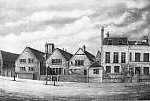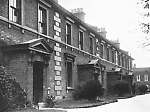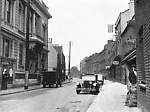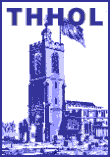Until the beginning of the last century White Horse Street was continuous from Stepney Churchyard to Butcher Row, which leads down to the riverside. It then was divided by the construction of the Commercial Road and this accounts for the present opposite streets in the modern thoroughfare each having the same name and the houses therein having one serial number.
This quiet street - very little traffic passes through it - is not remarkable in its appearance, as the existing buildings are neither of great age nor picturesque, so that anyone not acquainted with the associations connected with it will after a casual glance turn away, having seen but little of interest.
As a street it is very old; indeed, as the means of communication from the river in a northerly direction it was the only street throughout the East of London until modern times. It follows the line of the ancient trackway that was used long before the Norman Conquest, and extended for nearly two miles from the landing-place on the river to the manor house. The upper part of White Horse Street, that between the end of the churchyard and Ben Jonson Road, is often locally referred to as "the old road, " and quite recently three small boys under seven years of age were overheard in Harford Street to say that they were going into "the old road. " This is an instance of the means by which old names of otherwise forgotten things are passed down from one generation to another.
For how long White Horse Street has been known by its name cannot be stated, but for more than three hundred years it has been so described. There is a tradition which, though it may commend itself to the imagination as not being entirely a fiction, may not be accepted as an historical fact. In Saxon times, so runs the tale, the body of a Kentish warrior chief who had been slain fighting the Danes on the river was brought along this way to be interred in or by the hallowed ground beside the little chapel that stood on the site now occupied by St. Dunstan's Church. In commemoration there was erected nearby an emblem of the White Horse, the well-known badge of Kent. Inconclusive as this story may seem, equally unsatisfactory is the suggested derivation from the sign of a public-house. The prevalence of this sign in various parts of the kingdom, excepting perhaps Kent, is to be attributed to the "running " White Horse of Hanover which became familiar to the populace during the reigns of the first three Georges.
A long winding lane called White Horse Lane, after having wound through the fields from Whitechapel, ended in White Horse Street, and Rose Lane to the south of it continued the easterly way to Limehouse. Between Rose Lane and Butcher Row the land formed part of estates in the Corporation of London, in whom it had been vested by the patriotic Sir John Philpot who, in 1370, had acquired it in furtherance of his plan for the defence of the City against foreign enemies coming up the river.
The northern boundary of the hamlet of Ratcliff on the eastern side of the street is at Salmons Lane, but the western side continues to form it as far as Ben Jonson Road. In the eighteenth century the entry to "the town " was reckoned to be at the churchyard end, and the allusions in the minutes of the Trustees of the Hamlet to their watch and ward afford a vivid glimpse of the rural surroundings into which the street passed not very far from the end of Butcher Row. On either hand there stretched pasture land, lonely at night. For some years there had been a large number of burglaries and robberies, so that it became a common thing for residents to engage auxiliary watchmen, if not to protect them by physical means, at least to raise the alarm. In 1785 the inhabitants of White Horse Street, being dissatisfied with the poor protection afforded, subscribed among themselves for a private watchman to patrol that street. The parochial watchmen, who were paid 5s. a week, were provided "with suitable long coats. " In 1781 it is recorded that staves were provided "for each of the watchmen four feet six inches in length, also a cutlass, " but this was not enough, for a person was appointed "to learn the watchmen the use of the quarter-staff. " As to the watchman "who stands in the Churchyard " he was to have a blunderbuss. It may be added that the expense of armament was not great: the cost of six cutlasses and one blunderbuss being only one guinea.
This was the residential street of the hamlet, and consisted of the large houses having spacious gardens which were occupied, from the time of their building down to the nineteenth century, by a succession of captains and others engaged in shipping. It formed a contrast to the busy Broad Street down by the riverside where trade was carried on. Much land in White Horse Street and the immediate vicinity was acquired by John Colet, Dean of St. Paul's and sometime Vicar of Stepney, who devised it to the Mercers Company for the maintenance of St. Paul's School, which he founded in his lifetime and which, after being conducted on a site east of the Cathedral for three hundred and seventy years, was removed to Chiswick. The Dean reserved a house for the use of the Headmaster for his rest and retirement in the country air. These are the words of the Dean:-
"The High Maister shall have the Tenement in Stebinhith now in the handys of Christopher Middilton to resorte unto whiche Tenement the Mercers shall mayntayn and repaire. "
This house was situated at the corner of what was afterwards called Salmon Lane. After the Master of the School ceased to reside here the rent of the property was received by him and by his successors until it was sold in 1882 for about £1,408 - when the money was applied to the general endowment of the school. Because of this house being commonly called Dean Colet House, it has misled some to conclude that at some time the Dean occupied it. This is not so: the house in which he lived, and his parents before him, stood westwards of Stepney Church in what is now Spring Garden Place.
[Dean Colet House] stood for many years, and when it was demolished two Georgian houses having spacious rooms were built, the larger of the two being the one at the corner. It is interesting to note that it was occupied for many years by Mr. Thomas Wrake Ratcliff, who was a director of the Commercial Gas Company for twenty-eight years, becoming the chairman in 1890. When in 1855 the Act of Parliament creating District Boards and Administrative Vestries came into operation, Mr. Ratcliff was the clerk of the newly-founded Limehouse District Board. For nearly ten years - until the new offices were built on the west side of White Horse Street - the various committees met in the dining-room of his house. Both houses were pulled down in 1882, and on the site the vicarage for the district parish of St. Matthew was erected, and on the garden the Tower Hamlets Dispensary was built. The latter is now a church hall.
 The
illustration [left] shows, besides these two houses, the poorhouse adjoining - a barn-like building
- which was built in 1741 on the land held on lease from the Mercers Company. It appears from
an inquiry made in 1822 that there were some abuses connected with the establishment. Many of
the inmates were in receipt of pensions, no account was made of the clothing which was purchased
secondhand, and there was no order or good government, especially among the men "who lie abed
as long as they like and retire when they chose and work as they please. " It was recommended
that a certain number of inmates should keep the place in a clean state, that men, women and
children be separated, and that in future Sundays be observed and a Sunday-school established,
as no minister ever enters the place. To brighten the gloom of the picture, there may be added
that in 1817 it was resolved "that people in the workhouse to have buns and porter on Good Friday
and roast pork for dinner on Easter Sunday, also 6d. each, 3d. for children. "
The
illustration [left] shows, besides these two houses, the poorhouse adjoining - a barn-like building
- which was built in 1741 on the land held on lease from the Mercers Company. It appears from
an inquiry made in 1822 that there were some abuses connected with the establishment. Many of
the inmates were in receipt of pensions, no account was made of the clothing which was purchased
secondhand, and there was no order or good government, especially among the men "who lie abed
as long as they like and retire when they chose and work as they please. " It was recommended
that a certain number of inmates should keep the place in a clean state, that men, women and
children be separated, and that in future Sundays be observed and a Sunday-school established,
as no minister ever enters the place. To brighten the gloom of the picture, there may be added
that in 1817 it was resolved "that people in the workhouse to have buns and porter on Good Friday
and roast pork for dinner on Easter Sunday, also 6d. each, 3d. for children. "
 Facing
the churchyard are the almshouses belonging to the Mercers Company. They were rebuilt in 1857
at the cost of £2,945, and represent a generous fulfilment of the bequest of Dame Jane
Mico, widow of Sir Samuel Mico, knight, who died in 1666, during his Mastership of the Mercers
Company. She gave £1,500, with some of it to build almshouses for ten poor widows of the
age of fifty and upwards.
Facing
the churchyard are the almshouses belonging to the Mercers Company. They were rebuilt in 1857
at the cost of £2,945, and represent a generous fulfilment of the bequest of Dame Jane
Mico, widow of Sir Samuel Mico, knight, who died in 1666, during his Mastership of the Mercers
Company. She gave £1,500, with some of it to build almshouses for ten poor widows of the
age of fifty and upwards.
On the east side of White Horse Street, at the corner of Salmon Lane beneath the sheltering foliage, is a tiny graveyard which strangers have hastily concluded to be a severed portion of the churchyard. It is attached to the almshouses, which are vested in the Stepney Meeting or Body of Independants by the will of Captain Samuel Truelove, mariner, of Wapping Wall, who was a stout Cromwellian and a strong supporter of Stepney Nonconformity. He died in 1661 possessed of considerable wealth, and left his White horse Street property nominally to his nephew, but practically to Trustees of the Independants. The bequest was seized by the King, who granted it to one of his courtiers, Phillips by name, who gave it back to the rightful owners. The burial-ground which was purchased in 1779 - the first interment being in 1790 - was closed in 1853 by Order in Council.
 The
illustration [left] shows a general view of the northern part of White Horse Street at the present
time. On the left hand is seen the building which was erected in 1864 for the accommodation
of the Limehouse District Board of Works. It is now used as the offices of the Public Health
Department of the Borough of Stepney. The architectural merits may possibly not be fully recognised
as being in accordance with the ideas that prevail to-day, but it has in the past, because of
its dignified style, enjoyed the appreciation that modern taste lacks in its assumption of superiority.
The appearance of the building has not been improved by the attempt to change the once dull
grey into an unhealthy yellowish tone. Adjoining there stood, until twenty-five years ago, some
quaint old eighteenth-century houses, two of which were occupied by a clay pipe manufacturer;
and passers-by would often see the lumps of white Cornish clay taken into the premises through
a trap-door under the parlour window. A little way further on is the Green Coat School, which
was founded in 1710 by 117 leading inhabitants of the hamlet of Ratcliff, who assembled together
for that purpose. The plot of freehold land was purchased, and on it in 1720 a schoolhouse was
erected which remained standing until 1853, when it made way for the present buildings. On either
side of the doorway there are effigies, carved in 1759, of a boy and a girl in the costumes
of charity scholars at that time. We who pass and look at them should remember that charity
does not imply a social gulf parting those who give and those who receive, but is the common
bond of humanity.
The
illustration [left] shows a general view of the northern part of White Horse Street at the present
time. On the left hand is seen the building which was erected in 1864 for the accommodation
of the Limehouse District Board of Works. It is now used as the offices of the Public Health
Department of the Borough of Stepney. The architectural merits may possibly not be fully recognised
as being in accordance with the ideas that prevail to-day, but it has in the past, because of
its dignified style, enjoyed the appreciation that modern taste lacks in its assumption of superiority.
The appearance of the building has not been improved by the attempt to change the once dull
grey into an unhealthy yellowish tone. Adjoining there stood, until twenty-five years ago, some
quaint old eighteenth-century houses, two of which were occupied by a clay pipe manufacturer;
and passers-by would often see the lumps of white Cornish clay taken into the premises through
a trap-door under the parlour window. A little way further on is the Green Coat School, which
was founded in 1710 by 117 leading inhabitants of the hamlet of Ratcliff, who assembled together
for that purpose. The plot of freehold land was purchased, and on it in 1720 a schoolhouse was
erected which remained standing until 1853, when it made way for the present buildings. On either
side of the doorway there are effigies, carved in 1759, of a boy and a girl in the costumes
of charity scholars at that time. We who pass and look at them should remember that charity
does not imply a social gulf parting those who give and those who receive, but is the common
bond of humanity.
by Sidney Maddocks
